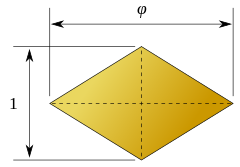
In geometry, a golden rhombus is a rhombus whose diagonals are in the golden ratio:[1]
Equivalently, it is the Varignon parallelogram formed from the edge midpoints of a golden rectangle.[1] Rhombi with this shape form the faces of several notable polyhedra. The golden rhombus should be distinguished from the two rhombi of the Penrose tiling, which are both related in other ways to the golden ratio but have different shapes than the golden rhombus.[2]
- ^ a b Senechal, Marjorie (2006), "Donald and the golden rhombohedra", in Davis, Chandler; Ellers, Erich W. (eds.), The Coxeter Legacy, American Mathematical Society, Providence, RI, pp. 159–177, ISBN 0-8218-3722-2, MR 2209027
- ^ For instance, an incorrect identification between the golden rhombus and one of the Penrose rhombi can be found in Livio, Mario (2002), The Golden Ratio: The Story of Phi, the World's Most Astonishing Number, New York: Broadway Books, p. 206
